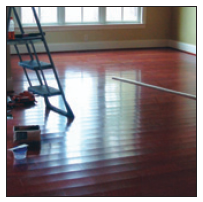My floor is cupped, what happened?
Cupping in a floor is a result of moisture. A cupped floor has the appearance of a "washboard" or "ripples" across the installation (perpendicular to the length of the flooring). The long edges of the flooring curl upward. How fast cupping occurs depends on the amount of moisture it is exposed to. Cupping is more common in warmer seasons and/or climates and with higher humidity. The wider the board, particularly in solid hardwood flooring, the more tendency it has to exhibit cupping. Slight seasonal cupping in wider solid plank floors in considered normal.

Why has my flooring cupped?
Cupping is not due to a defect in the flooring.
The moisture content of the underside of the floor has increased since the floor was flat, causing that side of the floor to expand faster than the top or "face" of the floor. This moisture typically originates in a basement or crawl space. Cupping may also be the result of plumbing problems, leaking doors/windows, or new construction moisture in the structure. Other common causes include poor site drainage, and HVAC systems not operating properly and continually. There is some GOOD NEWS—cupping will often relax if the moisture issues that caused it are resolved promptly. In such cases, no major repairs should be needed to recover a serviceable floor
What to do about cupping:
Any source of excess moisture MUST be identified and corrected FIRST, or any repairs, replacement, or refinishing will not be successful. Moisture problems may not be readily apparent; only qualified testing for the presence of moisture in the wood flooring and substrate will verify if site conditions are stable and at suitable levels. This will take time, possibly months. Only after the moisture conditions have stabilized can good remediation decisions be made—and only then should work begin. This may include replacement of some boards/areas affected, and/or sanding the flooring flat and refinishing.
Splits, cracks, and checks to the wood and/or finish and other symptoms of stress may be the result of more severe cupping, and may require repair or replacement as a result.
Is this a warranty issue?
The Somerset Limited Warranty specifically excludes cupping from coverage under the terms of the warranty. Cupping may be present in newly delivered hardwood flooring if it has not been properly transported, stored, and most importantly acclimated to proper site conditions. If hardwood flooring is cupped prior to installation, installation should definitely NOT PROCEED, and Somerset can determine if it was manufactured at appropriate moisture levels.
FOR MORE INFORMATION, REFER TO THE NATIONAL WOOD FLOORING ASSOCIATION
(NWFA) Technical Publication No. C200, p.7